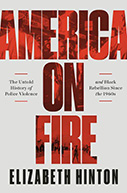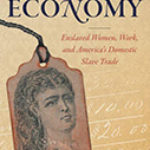America on Fire: The Untold History of Police Violence and Black Rebellion Since the 1960s

Author: Elizabeth Hinton
Publisher: Liveright Publishing Corporation, 2021. 408 pages
Reviewer: Stephen Bohigianǀ November 2021
When Elizabeth Hinton published her first book, From the War on Poverty to the War on Crime: The Making of Mass Incarceration in America in 2014, she challenged the orthodoxy established in large part by Michelle Alexander’s groundbreaking 2010 work The New Jim Crow: Mass Incarceration in the Age of Colorblindness that located the roots of the current crisis of mass incarceration in the Reagan administration’s aggressive War on Drugs. Instead, Hinton argued, the seeds of mass incarceration had been planted much earlier during Lyndon Johnson’s War on Crime, and amidst the largest expansion of the social safety net since the New Deal under the War on Poverty. By the time Reagan took office in 1981, billions of dollars had already been sent to states and local communities to help militarize police, build prisons, expand surveillance, and promote aggressive police patrols in low-income Black and Brown neighborhoods.
For her new book, America on Fire: The Untold History of Police Violence and Black Rebellion Since the 1960s, Hinton analyzes urban rebellion and police violence in historically under-analyzed communities, as well as better-studied cities like Los Angeles, since 1968. The book is divided into two parts and ten chapters (not including the Introduction and Conclusion). In “Part I: Origins,” Hinton focuses on the “crucible period” of urban uprisings in smaller cities like Cairo, Illinois, and York, Pennsylvania between 1968 and 1972. This era, she is correct to note, is less frequently studied and analyzed than the long, hot summers between 1964 and 1967. “Part II: Legacies” investigates the larger televised rebellions in Miami (1980), Los Angeles (1992), and Cincinnati (2001). Whereas crucible period rebellions usually emerged from the “policing of ordinary, everyday activity,” the rebellions covered in Part II were triggered by instances of extreme police violence and oftentimes legal exonerations of that violence (289).
America on Fire challenges historical and contemporary debates that label violent Black protest as “rioting” or “riots,” stripping them of their political salience and purpose. Instead, Hinton argues, they need to be understood as rebellions, which forestalls the inclination embraced by some white allies to empathize with the causes of rebellion, while believing that the rebellion itself is driven by a “pathological impulse, rooted in spontaneous, uncontrollable emotion” (4). The “fundamental reality,” Hinton shows, is that Black urban rebellion was often responding to and precipitated by overpolicing and police violence (15).
Part I includes seven chapters that focus on a specific theme related to the causes and nature of Black rebellion such as public housing, white vigilantism, “riot” commissions, and more. Chapter 1 sets up the larger motif of the book: the cycle of Black rebellion instigated by violent overpolicing. Hinton illuminates how communities like Carver Ranches in Broward County, Florida, “didn’t have sidewalks, fire hydrants, or a sewer system,” but had aggressive police patrols that responded violently to quotidian interactions with residents (19). This cycle defined Black life in low-income, segregated areas, as law enforcement maintained social control while the city failed to adequately fund infrastructure, better schools, or jobs programs.
In Chapter 2, Hinton focuses on several Black public housing projects, including Pyramid Courts in Cairo, Illinois. Public housing, according to Black residents, became “sites of oppression” due to the overbearing presence of the police (67). Despite concerted and partially successful desegregation campaigns by local NAACP and SNCC chapters in the early 1960s, Black Cairoites were still completely locked out of municipal politics and relegated to the flood-prone, dilapidated housing of Pyramid Courts. After Black residents rebelled in 1967, white Cairoites formed a vigilante group to terrorize the Black community through gunfire and racist threats. White supremacist violence peaked in 1969 when white locals perched themselves at the top of a levee and fired down on Pyramid Courts, only to be met with return gunfire. Cairo police either joined in or sanctioned this kind of terroristic violence, which continued until 1972.
Chapter 3 analyzes the significant role that white vigilantism played in fomenting Black rebellion. White Cairo residents founded a more formal armed vigilante group known as the White Hats to “support the local police” (74). Deputized by a local sheriff, the paramilitary group patrolled Cairo’s streets with police dogs, shotguns, and radios. Since so many members were police officers, the White Hats were given wide latitude to make citizens’ arrests of Black Cairoites under the guise of order maintenance. This type of vigilante terror was replicated throughout the North and the South, and often operated with the direct involvement, if not outright support, of law enforcement.
America on Fire tackles several myths surrounding policing and Black rebellion and self-defense. In Chapter 4, Hinton dismantles the myth of the Black rebellion sniper, arguing that the white media and public viewed Black self-defense (in this case, Black residents shooting at law enforcement) as “an illegitimate form of protest” (96). Sniping was especially terrifying to the white public because snipers could target police with impunity and anonymity. These fears were fed by the white media and therefore grew within the white imagination. Life magazine, for example, reported that “a fifty-member sniping group affiliated with SNCC had traveled to Newark” (99). It was later discovered that this story was fabricated and had no tangible connection to actual snipers. Ultimately, the fear of Black snipers, according to Hinton, prevented politicians from pursuing any strategy at community uplift as they poured more money into the War on Crime.
Chapter 5 confronts the contemporary idiom of “a few bad apples” that shields violent police officers from accountability. Hinton argues that “bad apples” do not exist without a poisoned tree (the idiom’s original meaning) and demonstrates that the Black community understood that bad apples were not just officers that kill without regard, but those “who assault residents verbally and physically…on an everyday basis” (125). Violent officers like Claiborne Callahan of Alexandria, Virginia, acted as instigators of rebellion by terrorizing Black children. Instead of taking community complaints about Callahan and the department seriously, the police portrayed the Black community as the problem. As the city ignored their pleas, Black residents rebelled twice in two years.
Chapter 6 focuses on the public school system as a site of student-led rebellion and as a space emblematic of the increasingly militarized law enforcement response to perceived disorder. After hundreds of Black students at John Harris High in Harrisburg, Pennsylvania, protested the lack of Black teachers and inclusive policies, school administrators called the police to disperse the crowd. The show of force, as in other rebellions of the period, had an incendiary effect, as students took their grievances to the streets. In detailing similar rebellions that began in the public school system in Burlington and Greensboro, North Carolina, Hinton shows that many of the students’ objectives (more Black teachers and courses, better textbooks, non-discriminatory dress code) were only achieved through a violent, rebellious show of force.
If rebellion defined the 1960s and 1970s, so too did the “riot commissions” convened to investigate those rebellions. In Chapter 7, Hinton notes that where these commissions, like the 1968 Kerner Commission, succeeded in discussing the causes of rebellion, they still failed to prevent future Black uprisings or lead to widespread, structural changes in the affected communities. The Kerner Report, which Hinton identifies as a “mostly progressive document,” established a rubric for future commission reports, where they identified the issues affecting the community and set forth a plan to address those issues (171). But implementation of their recommendations fell short, and ran into resistance from law enforcement. Looking at smaller studies, like one produced by the school board in Alexandria, Virginia, Hinton finds that while these reports were well-meaning and oftentimes produced by liberals, they “tended to pathologize Black residents,” with lines attributing protest to “black bravado,” while ignoring historical police brutality (175).
In Chapters 8-10, which comprise Part II, Hinton details the violent rebellions in Miami, Los Angeles, and Cincinnati. In doing so, she reveals one of the consistent, underlying themes of the entire book: Each city’s unwillingness to embrace structural police reform and invest in the very communities that rebelled.
The Miami, Los Angeles, and Cincinnati rebellions were each sparked by extraordinary instances of police violence and miscarriages of justice. In Miami, Black residents rebelled after four officers were acquitted for beating to death Liberty City (the Black area of Miami) resident Arthur McDuffie. The acquittals came near the end of fifteen months of egregious officer violence against the Black community—including when an officer molested an eleven-year-old Black girl. In Los Angeles, the acquittal of the four officers who beat Black motorist Rodney King sparked the largest urban rebellion in U.S. history. And, in Cincinnati, a city with a long history of police brutality and Black protest against that brutality, the country’s largest rebellion since 1992 was sparked after unarmed Black resident Timothy Thomas was shot and killed by an off-duty officer. Rather than just focusing on what happened during each rebellion, Hinton analyzes more understudied aspects of each, like the truce between the Crips and Bloods in Los Angeles and the Cincinnati Police Department’s federal consent decree. This offers a deeper understanding of the nuanced politics and attempts at reform that sought to address the root causes of each rebellion.
America on Fire is a remarkable and important work that contributes to a more nuanced understanding of not only Black rebellion, but federal and municipal politics, Black political power, criminal justice reform, and the overpolicing of low-income communities. Hinton shows that the opportunities to fix the perennial issues that plagued and continue to plague disinvested low-income Black and Brown communities have always been there. But city, state, and federal officials have chosen instead to invest money in more police, more prisons, and more punitive methods of social control and surveillance. Hinton makes a convincing case that violent Black rebellion and protest need to be analyzed as part of Black Americans’ attempts to petition for full citizenship and rights. For Hinton, separating nonviolent protest from urban rebellion treats Black protest as monolithic, and plays into arguments about the “right way” to protest.
Hinton writes with a clarity and accessibility that makes America on Fire appropriate for both undergraduate and graduate courses. Her comprehensive list of rebellions between 1964 and 2001 (which uses data from Professor Christian Davenport’s Radical Information Project at the University of Michigan’s Center for Political Studies), by itself, makes the book worthy of purchase.
For anyone interested in the history of Black rebellion and police power in the second half of the twentieth century, there are few works that are more nuanced and well-researched as America on Fire.
References:
Alexander, M. (2010) The New Jim Crow: Mass incarceration in the age of colorblindness. New York: The New Press.
Stephen Bohigian, Ph.D. is a Lecturer in the Department of History at California State University, Fresno


